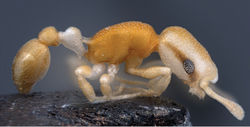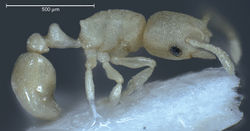Cardiocondyla pirata
| Notice: | This page is derived from the original publication listed below, whose author(s) should always be credited. Further contributors may edit and improve the content of this page and, consequently, need to be credited as well (see page history). Any assessment of factual correctness requires a careful review of the original article as well as of subsequent contributions.
If you are uncertain whether your planned contribution is correct or not, we suggest that you use the associated discussion page instead of editing the page directly. This page should be cited as follows (rationale):
Citation formats to copy and paste
BibTeX: @article{Seifert2013ZooKeys301, RIS/ Endnote: TY - JOUR Wikipedia/ Citizendium: <ref name="Seifert2013ZooKeys301">{{Citation See also the citation download page at the journal. |
Ordo: Hymenoptera
Familia: Formicidae
Genus: Cardiocondyla
Name
Cardiocondyla pirata Seifert & Frohschammer, 2013 sp. n. – Wikispecies link – ZooBank link – Pensoft Profile
Etymology
The species epithet refers to the black ribbon across the eye reminiscent of a pirate’s blindfold.
Type material
Holotype worker labeled “PHI: 14.1643°N, 121.2375°E, Los Banos, University Park, 58 m, Hortarium, Frohschammer 2008.07.23 #39” and ”Holotype Cardiocondyla pirata Seifert, 2013”; 4 workers, 3 dealate gynes and 1 ergatoid male labeled “PHI: 14.1643°N, 121.2375°E, Los Banos, University Park, 58 m, Hortarium, Frohschammer 2008.07.23 #39” and ”Paratype Cardiocondyla pirata Seifert, 2013”; 3 workers labeled “PHI: 14.1643°N, 121.2375°E, Los Banos, University Park, 58 m, in hole of a stone at riverside, Frohschammer 2008.07.23 #32” and ”Paratype Cardiocondyla pirata Seifert, 2013”; all material in Senckenberg Museum of Natural History Goerlitz.
Description and differential diagnosis. Measurements and indices in square brackets are arithmetic mean (see also Table 1).
Worker (Figs 1–2, Table 1): Unmistakable pigmentation pattern for an ant worldwide. Lateral head at horizontal level of eye with an extended, longitudinal, dark brown ribbon that is as broad as the eye; this ribbon is flanked below and above by broad bands without any pigment (as result appearing whitish). Vertex, scape, postpetiole, gaster, procoxae, tibiae and femora except their proximal and distal portions light yellowish brown. Mesosoma light orange brown. Petiole, meso- and metacoxae, clypeus, spines, funiculus as well as proximal and distal portions of femora without pigmentation (appearing whitish). Very small size [CS 397 µm]. Head moderately elongated [CL/CW 1.132]. Postocular distance relatively small [PoOc/CL 0.408]. Eye rather small [EYE/CS 0.226]. With maximum CL and CW in visual plane, outlines of head roughly heart-shaped, with strongly concave posterior margin and an almost straight anterior clypeal margin (a distinct concavity appears after a tilt to frontodorsal viewing position when the three clypeal macrosetae become fully visible). Frontal carinae much more closely spaced than in any related species [FRS/CS 0.242], subparallel and slightly diverging frontal of the FRS level. Mesosoma thickset, its dorsal profile evenly convex. Anterior pronotum in dorsal view rounded, without pronounced corners. Propodeal spines straight and much shorter than in any related species [SP/CS 0.208], in dorsal view slightly diverging, in lateral view straight and with their axis deviating by 40° from longitudinal axis of mesosoma. Petiole in lateral view rather massive, clearly higher than postpetiole, with a short peduncle, a slightly concave anterior profile and a convex dorsal node that steeply slopes down to the caudal cylinder; the node in dorsal view semiglobular and slightly wider than long. Postpetiole in dorsal view with a straight or slightly concave anterior margin, rounded sides and much wider than long; its sternite with pronounced anterolateral corners that are formed by bilateral lobes which strongly protrude compared to anteromedian level. Whole surface of head, mesosoma and petiole with a very fine (mesh diameter on vertex only 8-9 µm) but deeply sculptured reticulum, thus appearing at lower magnifications perfectly matt. Postpetiole less deeply sculptured. Scapes, coxae, femora and tibiae with fine microreticlum and appearing matt at lower magnifications. First gaster tergite very finely microreticulate-shagreened, also appearing matt at lower magnifications. All cuticular surfaces including those of the appendages with decumbent, dilute pubescence. Pubescence on 1st gaster tergite much longer and denser than in any related species [PLG/CS 7.21%, sqPDG 3.92], on anterior surface directed caudad and on posterior one caudomediad. For morphometric data of 6 workers (three from each sample) see Table 1.
| sp.: ARGE, ARGY, ARPI, LATI, MISE | Cardiocondyla pirata sp. n. | |||
|---|---|---|---|---|
| worker (n=174) | worker (n=6) | gyne (n=3) | male (n=1) | |
| CS [µm] | 423 ± 45 [358,556] |
397 ± 4 [392,402] |
437 ± 3 [433,440] |
341 |
| CL/CW | 1.113 ± 0.027 [1.040,1.182] |
1.132 ± 0.010 [1.120,1.147] |
1.152 ± 0.005 [1.146,1.155] |
1.070 |
| SL/CS | 0.829 ± 0.018 [0.785,0.892] |
0.807 ± 0.005 [0.800,0.816] |
0.792 ± 0.011 [0.782,0.804] |
0.707 |
| PoOc/CL | 0.418 ± 0.011 [0.389,0.455] |
0.408 ± 0.005 [0.404,0.416] |
0.401 ± 0.002 [0.398,0.402] |
0.420 |
| EYE/CS | 0.228 ± 0.009 [0.204,0.247] |
0.226 ± 0.002 [0.223,0.229] |
n.r. | 0.210 |
| dFov [µm] | 16.4 ± 1.8 [10.9,20.0] |
8.6 ± 0.3 [8.2,9.0] |
13.7 ± 2.8 [10.9,16.5] |
n.r. |
| FRS/CS | 0.325 ± 0.020 [0.263,0.357] |
0.242 ± 0.007 [0.235,0.254] |
0.248 ± 0.006 [0.242,0.254] |
0.347 |
| MW/CS | n.r. | n.r. | 0.797 ± 0.016 [0.784,0.815] |
0.789 |
| ML/CS | n.r. | n.r. | 1.301 ± 0.005 [1.297,1.306] |
1.161 |
| MGr/CS | 0.38 ± 0.36 [0.0,1.48] |
0.0 ± 0.0 [0,0] |
n.r. | 0.0 |
| SPBA/CS | 0.358 ± 0.020 [0.303,0.414] |
0.373 ± 0.005 [0.364,0.378] |
0.438 ± 0.015 [0.422,0.452] |
0.351 |
| SP/CS | 0.366 ± 0.062 [0.232,0.476] |
0.208 ± 0.004 [0.204,0.214] |
0.229 ± 0.005 [0.223,0.232] |
0.161 |
| PEW/CS | 0.310 ± 0.020 [0.267,0.362] |
0.359 ± 0.004 [0.355,0.367] |
0.392 ± 0.002 [0.391,0.394] |
0.419 |
| PPW/CS | 0.459 ± 0.028 [0.397,0.531] |
0.468 ± 0.004 [0.462,0.475] |
0.532 ± 0.007 [0.524,0.537] |
0.582 |
| PEH/CS | 0.355 ± 0.018 [0.315,0.422] |
0.343 ± 0.006 [0.335,0.354] |
0.391 ± 0.006 [0.386,0.398] |
0.387 |
| PPH/CS | 0.299 ± 0.031 [0.231,0.359] |
0.320 ± 0.008 [0.308,0.328] |
0.361 ± 0.005 [0.358,0.366] |
0.372 |
| sqPDG | 5.34 ± 1.04 [3.42,8.25] |
3.92 ± 0.13 [3.74,4.12] |
2.63 ± 0.07 [2.55,2.68] |
3.66 |
| PLG/CS [%] | 4.37 ± 1.21 [2.14,6.75] |
7.21± 0.26 [6.87,7.54] |
7.68 ± 0.24 [7.49,7.95] |
9.53 |
Comments
Cardiocondyla pirata sp. n. cannot be confused with any ant worldwide because of its unique pigmentation pattern. This clear identification is supported by diagnostic structural and shape characters: there is no overlap with the five other undescribed species of this species group in the characters FRS/CS, SP/CS and PLG/CS and there is little overlap in PEW/CS and sqPDG (Table 1).
One complete colony consisting of three dealate queens, 15 workers and brood was collected in the field. From a second colony, only a sample was taken in EtOH. The first colony produced over 20 female sexuals and one ergatoid male in the lab, but thereafter died. Hence, there are no long-term observations on the life history of this interesting species. Considering the situation in related species of the Oriental and Indo-Malayan region (Heinze et al. 2010[1], Oettler et al. 2010[2]), we may predict for Cardiocondyla pirata sp. n. the following biological traits: (a) there are only ergatoid males - winged males, which are an ancestral trait in Cardiocondyla, are no longer developed, (b) ergatoid males are long-lived, mate always inside the nest and try to kill rivals using their sickle-shaped mandibles in order to monopolize the matings and (c) nests should contain 1–4 queens.
The adaptive significance of the extraordinary pigmentation pattern of these tiny ants remains a puzzle. The poor resolution of the visual system (workers and males have only 50–65 ommatidiae per eye) and the dominance of chemical and tactile recognition cues in these ants as well as the fact that mating happens in darkness of the nest certainly exclude a function as an intraspecific recognition signal. A possible function could be visual dissolution of body shape by alternating dark and light pigment in order to escape the attention of a predator. The unpigmented petiole in particular, being in living condition rather translucent, permits the visual impression that anterior and posterior body are separate objects. Remains the question: Which predator with a high-performance visual system could consume these tiny ants?
Original Description
- Seifert, B; Frohschammer, S; 2013: Cardiocondyla pirata sp. n. – a new Philippine ant with enigmatic pigmentation pattern (Hymenoptera, Formicidae) ZooKeys, 301: 13-24. doi
Other References
- ↑ Heinze J, Schmidt C, Nugroho H, Seifert B (2010) Wingless fighter males in the Wallacean ant Cardiocondyla nigrocerea (Insecta: Formicidae) – The Raffles Bulletin of Zoology 58 (2): 323–328.
- ↑ Oettler J, Suefuji M, Heinze J (2010) The evolution of alternate reproductive tactics in male Cardiocondyla ants. – Evolution 64/11: 3310–3317. doi: 10.1111/j.1558-5646.2010.01090.x
Images
|





